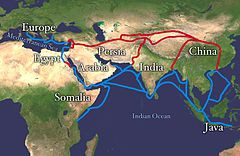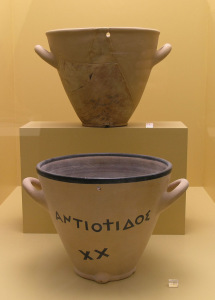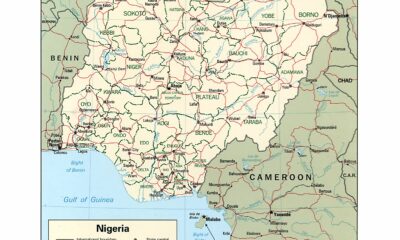Human Interest
Silk Road notes 6: time

This critique of the Cleveland Museum of Natural History’s Silk Road exhibit continues with further distortions of history. This includes how Arabic numbers got their name, though they were not Arabic originally.
The Silk Road notes: time
EXHIBIT SIGNS
A MECHANICAL MARVEL
Among the most dazzling treasures of the Abbasid age were its inventions: machines that performed all kinds of tasks, from serving drinks to telling time. This model is based on a water-powered clock designed around 800 years ago by the Arab inventor Abu al-Izz ibn Ismail al-Jazari. As a court engineer, al-Jazari devised plans for 50 miraculous gadgets in all, including faucets that spewed wine and water, mechanical peacocks and a robotic musical band.
COUNTING THE HOURS
Water clocks have a long history. In Egypt and Babylonia, they were used as early as 1500 BC. This drawing shows a Chinese water clock designed in AD 1088. Islamic craftsman borrowed Greek ideas when designing their own water clock, but they may also have admired the clockwork of their Chinese partners in trade. In early Baghdad, China was known not only for its fine ceramics, but also its highly skilled hydraulic engineers.
WHAT WASN’T SAID

A Greek water clock or clepshydra, from a 5th century BC original. Photo: User Marsyas on Wikimedia Commons, CC BY-SA 2.5 Generic License
That we owe the invention of the water clocks entirely to the Greeks and Chinese.
EXHIBIT SIGN:
WATER CLOCK
Book of Mechanical Devices
Leaf from the Book of Knowledge of Ingenious Mechanical Devices, Probably Cairo, Egypt 1354, Abu-al-Izz Ismail al-Jazari
To entertain wealthy patrons, Baghdad scholars invented fantastic machines. An Islamic craftsman designed the depsydra or water clock, around AD800. A water wheel on the upper level controls the flow of water through the clock to measure time.
How does it work. A scribe sits in the center of a clock face. As water flows steadily from the upper tank to the lower tank, pulling a system of pulleys that cause the scribe to turn. In the original design, a servant emptied the lower tank and refilled the upper tank each day. In this model, an electric pump does the same job.
WHAT WASN’T SAID
That they may have originated in Cairo, Egypt, but also in Babylon, India, China, with the probability of China as early as 4000 BCE, unaided by the highly skilled Islamic scholars and craftsmen.
FACTS
[ezadsense midpost]
- The huge planetary clock-type models, driven by water and considered the forerunners of today’s mechanical clocks, originated during the 13th century and were discovered in China, the Middle East and North America.
- A water clock or clepsydra (Greek κλέπτειν kleptein, ‘to steal’; ὕδωρ hydor, ‘water’) is any timepiece in which time is measured by the regulated flow of liquid into or out from a vessel where the amount is then measured. These and the sundials, are likely to be the oldest time-measuring instruments, with the only exceptions being the vertical gnomon and the day-counting tally stick.
- Their precise origin may never be known, but the bowl-shaped outflow (simplest form) is known to have existed in Babylon and in Egypt, c. 16th century BC. India and China also have early evidence of water clocks, dates less certain. Some claim that water clocks appeared in China as early as 4000 BC. Therefore, inventors could be Chinese, Babylonian, Egyptian, or Indian, not Islamic.
- The Greeks and Romans advanced water clock designs to include the inflow clepsydra with an early feedback system, gearing, and escapement mechanism, which were connected to fanciful automata and resulted in improved accuracy. Further advances were made in Byzantium, Syria and Mesopotamia, where increasingly accurate water clocks incorporated complex segmental and epicyclic gearing, water wheels, and programmability, advances, which eventually made their way to Europe. Independently, the Chinese also developed gears, escapement mechanism, and water wheels, and passed them on to Korea and Japan
- Some water clock designs were developed independently and transferred through trade. Early water clocks were calibrated with a sundial, replaced by the pendulum clocks in 17th c. Europe.
The Silk Road Notes: numbers
EXHIBIT SIGN:
NEW NUMBERS
At the House of Wisdom in Baghdad, scholars pored over Indian books or mathematics. These works used a set of ten symbols to represent numbers – not letters of the alphabet as in Baghdad and Rome, in the early 800s; mathematician Muhammad ibn Musa al-Khwarizmi wrote a book on doing math using the Indian system. Three centuries later, it was translated into Latin. Eventually, people all over Europe followed al-Khwarizmi’s example, switched to “Arabic” numerals we use today.
WHAT WASN’T SAID
That the books were Indian, the symbols were Indian, and the Islamic mathematician wrote the book using Indian symbols, but the numerals are called “Arabic,” a misappropriated title.
(To be continued)
Earlier Silk Road Notes articles:
- Silk Road notes 5: ships
- Silk Road notes 4: learning
- Silk Road notes 3: glass
- Silk Road notes 2: trade
- Silk Road notes 1: silk
[ezadsense leadout]
[subscribe2]
Author of “Confronting the Deception,” Tabitha Korol began her political career after 9/11, with letters to the editor and essays, developing a readership and earning two writing awards along the way. Her work appeared on Academia.edu, Christian Action Network, Conservative News and Views, Dr. Rich Swier, iPatriot, Liberty News & Views, LobbyistsforCitizens.com; Published Reporter, Renew America, Ted Belman, The Noisy Room, Trevor Loudon’s New Zeal, Virginia Christian Alliance, WebCommentary, and others.
-

 Civilization2 days ago
Civilization2 days agoDC Pipe Bomb Arrest Raises Questions About Christopher’s Wray’s FBI
-

 Civilization5 days ago
Civilization5 days agoYoo Hoo, VP Vance—Your Character is Showing!
-

 Executive5 days ago
Executive5 days agoThe Last Supper: New York’s Socialist Feast
-

 Guest Columns4 days ago
Guest Columns4 days agoCongressional Leaders See Far Higher Stock Returns Than Peers
-

 Civilization3 days ago
Civilization3 days agoThe Legal Logic Behind U.S. Operations Against Narco-Terrorist Networks
-

 Civilization5 days ago
Civilization5 days agoFacing Facts & Rolling Back Mythologies: The New National Security Strategy
-

 Civilization4 days ago
Civilization4 days agoHow Trump Changed America
-

 Executive3 days ago
Executive3 days agoNewsom’s ‘National Model’ for Homeless Wracked by Fraud















Meredith Mascitello liked this on Facebook.
[…] Silk Road notes 6: time […]
[…] Silk Road notes 6: time […]